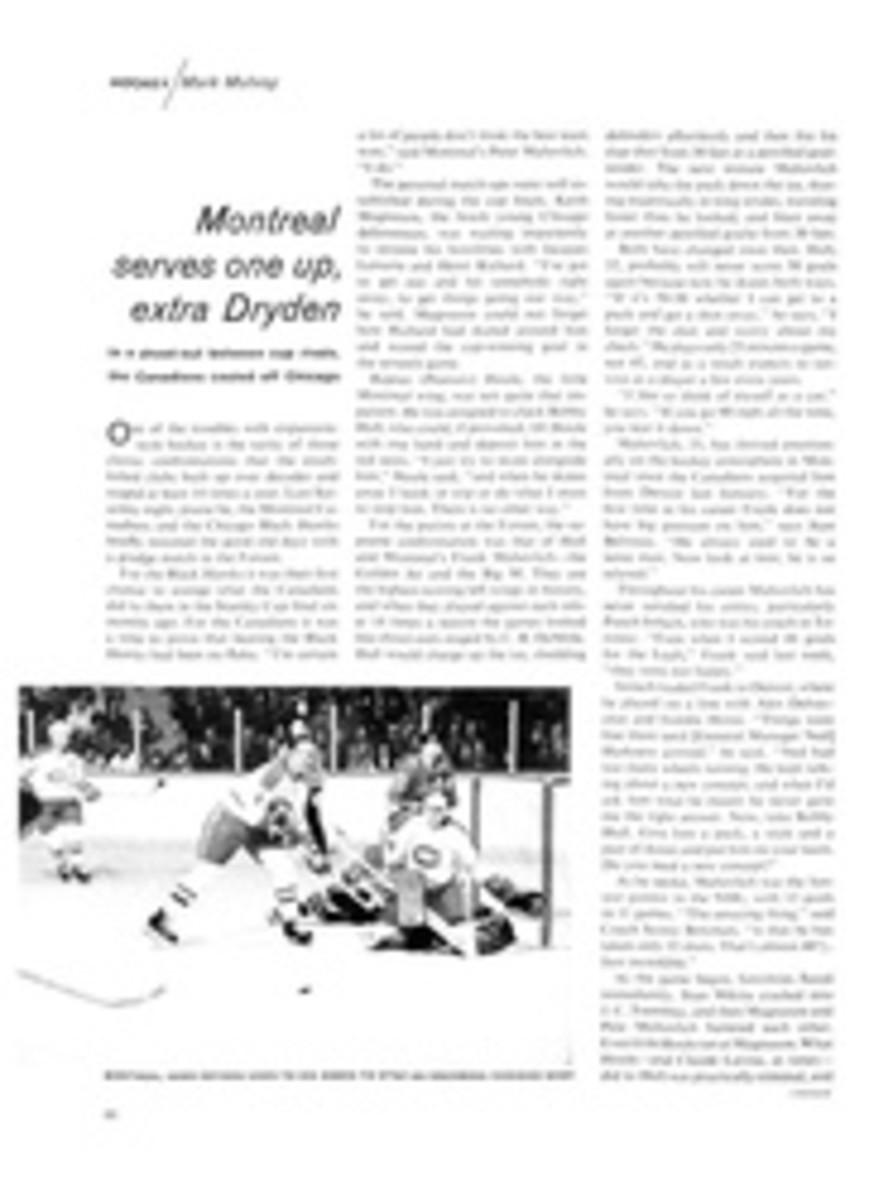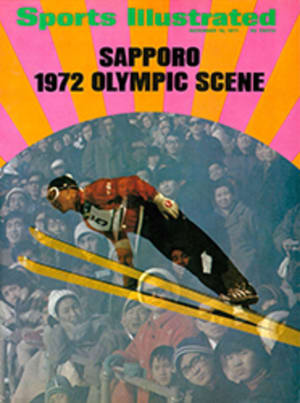
Call it catch-as-catch-can
Everyone is up to date in Kansas City on the deeds of Otis Taylor, the flanker for the Chiefs. People talk about him constantly, like 11th century Spaniards adding to the epic of El Cid or Wagner savoring the triumphs of Siegfried. From Coach Hank Stram on down to the headwaiter at the Plaza Inn, who has been known to ask Taylor for at least half a dozen autographs during dinner, everyone has a favorite Otis Taylor play to recall. As a matter of fact, Stram has two, and both occurred in the recent game against the heretofore undefeated Washington Redskins. The Chiefs were losing 20-13 in the fourth quarter. They were back on their 10, third down, 18 yards to go. Quarterback Len Dawson flipped a short pass to Taylor on the 14. Taylor skipped by one tackier and headed upfield, where four Redskins hit him on the 26. He carried the four of them with him for three more yards and the first down. "That's emotion, emotional stamina!" exults Stram. "Otis is a winner. That was the big play of the game for us." Four plays later the Chiefs tied the score.
With only a few minutes left, the Chiefs scored the winning touchdown on a 28-yard pass from Dawson to Taylor, who again performed in spectacular fashion. As he crossed the goal line, he leapt for the pass, and at the same time Pat Fischer of the Redskins, who was alongside, wrapped his arms around Taylor, pinning Taylor's left arm to his side. So Taylor reached up with his right hand to haul in the ball for the score. Stram was so excited he ran out on the field to hug Taylor coming back to the bench.
One of the great things about Taylor is that, for the most part, he keeps adding to his legend with each game he plays, much in the manner of Der Ring des Nibelungen. Last Sunday against the Jets was an exception. Taylor caught but two passes for 35 yards as the Chiefs were upset 13-10. Dawson threw to him only four times. One ball soared over his head and the other time he slipped in the mud. Nonetheless, Taylor has gained 683 yards this season, more than any other NFL receiver, and he has a good chance of bettering his own record of 1,297 yards set in 1966.
Now 29 and in his seventh season with the Chiefs, Taylor was born in Houston and raised by his mother, a domestic, and an older sister who is a nurse. Always a fast runner—he can do the 40 in 4.4—he hunted rabbits as a boy by chasing them down and then whacking them with a stick. At Evan E. Worthing High School he played quarterback, and although he could (and still can) throw a football 75 yards, he went to Prairie View A&M on a basketball scholarship. He was the quarterback until his sophomore year, when he was replaced by Jim Kearney, now a safety with the Chiefs. "We did some fantastic things together at Prairie View," Taylor recalls. "Jim would just tell me to get free, and then he'd whip it 50, 60, 70 yards. If there ever was a quarterback, he was one."
Taylor credits much of his proficiency in football to basketball. "It helped the quickness, the agility," he says. "I tried to do the things Elgin Baylor did. I saw this man while I was in high school, and I just fell in love with him. I wasn't a great shooter. I played forward and center. You might not believe this, but Willis Reed and I played to a 13-13 point standoff in college. He bloodied my nose, but I never did quit."
Drafted fourth by the Chiefs in 1965, Taylor almost didn't get to play in the American Football League. For a week he and several other college players, including Spider Lockhart, who is now with the Giants, were under the thumb of an NFL "baby-sitter" in Dallas who kept shifting them from one hiding place to another. The baby-sitter made the mistake of constantly telling Taylor how great Bob Hayes was doing with the Cowboys, and so when Lloyd Wells, an old friend and Kansas City scout, made secret contact, Taylor sneaked out a window to sign with the Chiefs.
Although Taylor has speed, strength and size (6'3", 215 pounds), he is obsessed with self-perfection. His one-handed catch against the Redskins was no fluke. He regularly practices catching the ball either left-handed or right-handed, even in the crook of one elbow. In practice he also works on catching a ball running at full speed with his arms folded behind his back. "This is my job," he says. "If a ball is thrown to me, I should catch it. A ball can come in so many ways, and I do these things in practice because something awkward may happen in a game. God did give me two hands to catch with, and if the ball comes when I can't use one of them, I'll use the other. I'm not defeated."
Whenever the Chiefs' defensive backs gather to watch a film of an upcoming opponent, Taylor watches, too. He wants to see other receivers in action on the chance he might learn something from them. As he puts it, Paul Warfield of the Dolphins is "Mr. Slant, that's what I call him. He's put a patent on that pattern. You're running in an area where there's a lot of people. It's a quick pattern, and when you catch the ball you're likely to be hit. You can't hear footsteps. The main thing is to catch the ball. I figure that if I can look at War-field or Charley Taylor and pick up some little things they're doing, I'm going to be a better receiver. I don't ever feel like I know too much about being a receiver.
"For six years I've been trying to run a sideline like Chris Burford or Ray Berry. No one had their moves from the line of scrimmage to 15 yards. George Sauer was Mr. Moves. Gene Washington at Frisco, he gets open in unusual situations. If you can take a little bit from these guys, this is beneficial to you. I don't look at young receivers—I'm not down on them, they've got a lot going—but I try to concentrate on the guys who've been around." Whatever Taylor learns, he shares with younger receivers on the Chiefs, such as Morris Stroud, a 6'10", 265-pound tight end, and Elmo Wright, a jewel of a rookie. Similarly, when the defense is on the field during the course of a game, Taylor studies the opposing receivers. Should he spot a pattern, he will shout to the secondary, and as Cornerback Emmitt Thomas says, "You listen."
When Taylor is on the field he always checks the sidelines upon leaving the huddle to see how many yards are needed. The bump-and-run does not bother him. "You have to work harder to get open," he says, "but I'm blessed with my size, my strength. If the defensive back lunges, and I'm not there, he's dead." Once play starts, Taylor says, "I try to elude the defensive back and stay far enough away so he can't touch me or knock me off stride."
Quick to pick up defenses, Taylor is, according to Dawson, very adept at finding the open areas in a zone. "He has such great reflexes and great hands," Dawson says, "but it isn't the hands—it's the head."
How Taylor catches a ball depends on where it is thrown. "If the ball is away from me," he says, "I run with the drive of a trackman, and then at the last second I put my hands out. If you run with your hands out, you'll never get it." Should a defensive back stay right with him, Taylor may suddenly stop to jump for the ball, reasoning that the back has too much momentum to brake with him. Taylor did this against the Steelers, only to drop the ball when he fell to the ground. "I was disheartened," he says, "but there's never a ball game that I've played where I don't think later about what I could have done better."
For Taylor life begins anew every time he receives a pass. "I just don't settle for the catch," he says. "I love to run. I don't know what's going to happen. I go on instinct. I'll jump, I'll skip, I'll dance sideways, anything to get the ball farther downfield." He rather enjoys the challenge of his matchups against the better defensive backs, such as Willie Brown of the Raiders. In a way, Taylor even relishes a good "pop" from an opponent; he tries to learn from them. Recalling a game against the Rams, he says, "I came off the line with just a glide, and the left linebacker, No. 32 [Jack Pardee], slapped me with an elbow, and he said, 'You better know what you're doing.' And I said to myself, 'Lord, I'd better learn,' and I'm glad he gave me that pop. It was a teaching pop."
Is there nothing then that can stop Taylor? Pat Fischer, who has been described as speaking of Taylor in "a low, awed voice that would have been appropriate for a scientist who has just been given a glimpse of the ultimate weapon," said he couldn't have been any closer when Taylor made his game-winning catch. Playing him tight won't work and neither will playing him loose. According to Willie Mitchell, an ex-defensive back for the Chiefs, there is only one way to beat his friend. Mitchell was sitting in Taylor's Kansas City nightclub, the Flanker's Lounge, one evening last week when he gave voice to his scheme. "I'd tell you what I'd do," he said, leaning back with a leer. "I'd bite him, and I'd get down in there and twist his leg." The din from the band almost drowned out Mitchell's catalog of horrors. "I'd say mean things about his momma," Mitchell went on. "And I'd spit, really spit, right on his face. I'd try to get him so angry he'd fight and get thrown out of the game. That's the only way to beat Otis Taylor."
PHOTO

